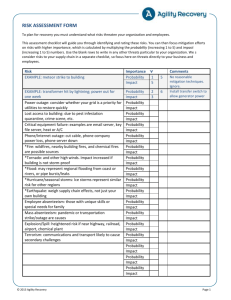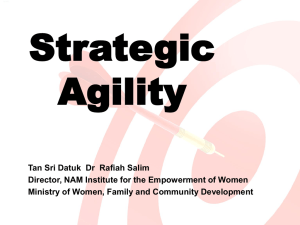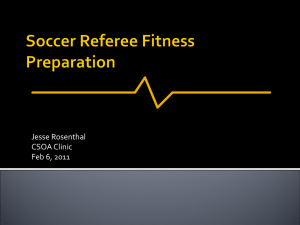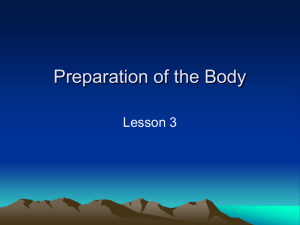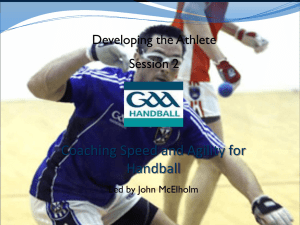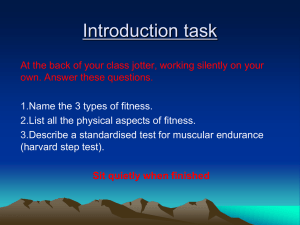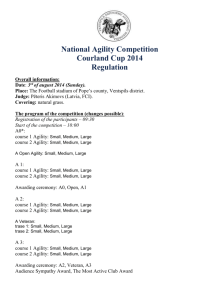agility astro-course - Mission X Train Like An Astronaut
advertisement
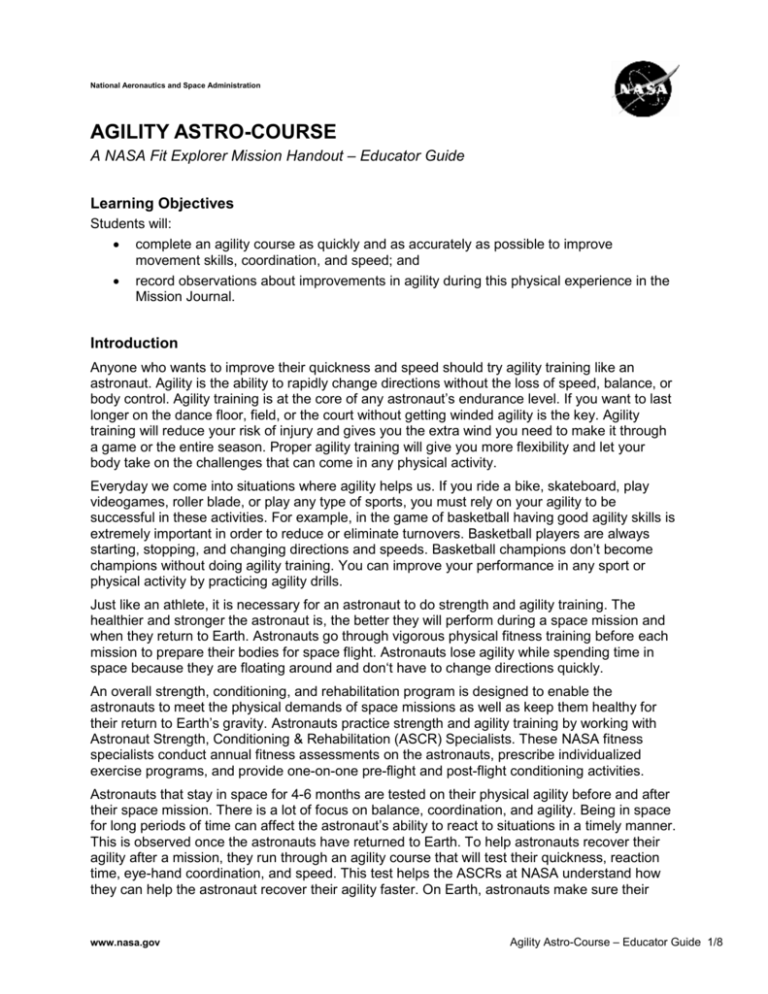
National Aeronautics and Space Administration AGILITY ASTRO-COURSE A NASA Fit Explorer Mission Handout – Educator Guide Learning Objectives Students will: complete an agility course as quickly and as accurately as possible to improve movement skills, coordination, and speed; and record observations about improvements in agility during this physical experience in the Mission Journal. Introduction Anyone who wants to improve their quickness and speed should try agility training like an astronaut. Agility is the ability to rapidly change directions without the loss of speed, balance, or body control. Agility training is at the core of any astronaut’s endurance level. If you want to last longer on the dance floor, field, or the court without getting winded agility is the key. Agility training will reduce your risk of injury and gives you the extra wind you need to make it through a game or the entire season. Proper agility training will give you more flexibility and let your body take on the challenges that can come in any physical activity. Everyday we come into situations where agility helps us. If you ride a bike, skateboard, play videogames, roller blade, or play any type of sports, you must rely on your agility to be successful in these activities. For example, in the game of basketball having good agility skills is extremely important in order to reduce or eliminate turnovers. Basketball players are always starting, stopping, and changing directions and speeds. Basketball champions don’t become champions without doing agility training. You can improve your performance in any sport or physical activity by practicing agility drills. Just like an athlete, it is necessary for an astronaut to do strength and agility training. The healthier and stronger the astronaut is, the better they will perform during a space mission and when they return to Earth. Astronauts go through vigorous physical fitness training before each mission to prepare their bodies for space flight. Astronauts lose agility while spending time in space because they are floating around and don‘t have to change directions quickly. An overall strength, conditioning, and rehabilitation program is designed to enable the astronauts to meet the physical demands of space missions as well as keep them healthy for their return to Earth’s gravity. Astronauts practice strength and agility training by working with Astronaut Strength, Conditioning & Rehabilitation (ASCR) Specialists. These NASA fitness specialists conduct annual fitness assessments on the astronauts, prescribe individualized exercise programs, and provide one-on-one pre-flight and post-flight conditioning activities. Astronauts that stay in space for 4-6 months are tested on their physical agility before and after their space mission. There is a lot of focus on balance, coordination, and agility. Being in space for long periods of time can affect the astronaut’s ability to react to situations in a timely manner. This is observed once the astronauts have returned to Earth. To help astronauts recover their agility after a mission, they run through an agility course that will test their quickness, reaction time, eye-hand coordination, and speed. This test helps the ASCRs at NASA understand how they can help the astronaut recover their agility faster. On Earth, astronauts make sure their www.nasa.gov Agility Astro-Course – Educator Guide 1/8 agility has returned to the same state as before their mission by staying active with a regular physical fitness routine. Administration Follow the outlined procedure in the Agility Astro-Course Mission Handout. The duration of this physical activity can vary, but will average 15-30 minutes per class. In order for students to perform at their maximum potential, positive reinforcement should be used throughout the activity. Location Because students will begin on the ground, this physical activity will best be performed on a non-slip flat surface such as a gym floor, outside in dry grass, or on a 5-lane athletic track. Description The length of the course is 10 meters (33 feet) and the width (distance between the start and finish points) is 5 meters (16.5 feet). Four cones are used to mark the start, finish, and the two turning points. Another four cones are placed down the center an equal distance apart 3.3 meters (11 feet) apart between each cone. Agility Astro-Course Adapted from the Illinois Agility Course www.nasa.gov Agility Astro-Course – Educator Guide 2/8 Procedure Using a stopwatch or clock with a second hand, time the students as they complete one lap through the course. Run the course to demonstrate to the students the proper path to take in the course. Have students form one line and complete the course one at a time. Students should lie on their front (similar to starting a push up) with hands by their shoulders. The stopwatch starts on the ‘Go’ instruction. The student gets up quickly and runs around the course in the direction indicated without knocking the cones over. Time is stopped when the student crosses the finish line. Equipment Educator Eight marking cones, or other small, steady objects Measuring tape or meter stick Paper and pencil Watch or stopwatch If a watch or stopwatch is unavailable, introduce a counting technique for record keeping such as: o Repeat each of the following words to equal one second of time: One Mississippi, two Mississippi, three Mississippi, etc One hippopotamus, two hippopotamus, three hippopotamus, etc o Keep cadence with a metronome Sync the metronome with the second hand on a stopwatch, clock, or watch Lightly tap your thigh to the beat of the metronome Each tap, or beat, will equal one second Student Mission Journal and pencil Optional Equipment Swimming noodles placed on the cones to create a more challenging course. Safety Avoid obstacles, hazards, and uneven surfaces Students must wear the appropriate clothes and shoes that allow them to move freely and comfortably. Proper hydration is important before, during, and after any physical activity. Be aware of the signs of overheating. A warm-up/stretching and cool-down period is always recommended. For information regarding warm-up/stretching and cool-down activities, reference the Get Fit and Be Active Handbook (ages 6-17) from the President’s Council on Physical Fitness and Sports at http://www.presidentschallenge.org/pdf/getfit.pdf. www.nasa.gov Agility Astro-Course – Educator Guide 3/8 Monitoring/Assessment Ask the Mission Question before students begin the physical activity. Have students use descriptors to verbally communicate their answers. Use the following open-ended questions before, during, and after practicing the physical activity to help students make observations about their own physical fitness level and their progress in this physical activity: How do you feel? Are you getting more tired each time you complete the course? Are you getting better each time you practice the course? How do you know you are getting better? What do you think would be more difficult for an astronaut: completing this course after a 14-day mission or a six-month mission? Why? o An astronaut working in space for a six-month mission will have a more difficult time completing the agility course when they return to Earth. During longer missions, an astronaut’s body has been exposed to the microgravity environment for a longer period of time. Because of this, the body will take longer to adapt to the Earth environment. Astronauts must get as much exercise as they can in order to help their bodies prepare for the Earth environment. Do you think an astronaut could successfully complete this course the day they landed from a 6-month mission? A week later? A month later? o An astronaut could complete the agility course after being in space for a six month mission, although as time goes on their performance will improve. The astronaut’s body will become better adapted to Earth’s environment each day they are back on Earth. The astronaut will begin to perform as they did before spaceflight and in some cases even better then when they went into space. Being healthy and fit upon their return to Earth will help the astronaut regain their strength and agility faster. Some quantitative data for this physical activity may include: length of time to complete the course number of penalties (knocked-over cones) length of rest period number of times the course was completed rate of perceived exertion (on a scale of 1-10) Some qualitative data for this physical activity may include: identifying environmental impacts identifying physical readiness (stretched out, warmed up, alertness, diet, adequate rest) identifying soreness in specific body parts Collect, Record, and Analyze Data Students should record observations about their physical experience in skill with movement, coordination, and speed in their Mission Journal before and after the physical activity. They www.nasa.gov Agility Astro-Course – Educator Guide 4/8 should also record their physical activity goals and enter qualitative data for drawing conclusions. Monitor student progress throughout the physical activity by asking open-ended questions. Time should be allotted for the students to record observations about their experience in their Mission Journal before and after the physical activity. Graph the data collected in the Mission Journal on the graph paper provided, letting students analyze the data individually. Share graphs with the group. Students should practice the Mission Handout physical activity several times before progressing or trying the related Fitness Acceleration and Mission Explorations. Fitness Acceleration Using the same charted Agility Astro-Course, move the cones and make up a new agility course that is a larger with more cones or shorter distance with less cones. How difficult is this course to complete? Do jumping jacks for 30 seconds and immediately try the agility course again. Did your time increase or decrease? Change the environment in which the course is performed (i.e. inside to outside). Decrease rest time. Mission Explorations Stand on one leg. Wave your arms and other leg about and still try to keep your balance. Participate in a field sport such as soccer or a racket sport such as tennis. Race with a partner against other pairs of students in your group. o Stand beside your partner. Using a scarf or bandana, tie you and your partner’s legs that are nearest to each other together at the ankle. o Race a measured distance to the finish line. Participate in sack races. o Step into a sack made of burlap, pulling it over your feet and up around your waist. o Hold the sack in place, and race against other students by hopping to the finish line. National Standards National Physical Education Standards: Standard 1: Demonstrates competency in motor skills and movement patterns needed to perform a variety of physical activities. Standard 2: Demonstrates understanding of movement concepts, principles, strategies, and tactics as they apply to the learning and performance of physical activities. Standard 3: Participates regularly in physical activity. Standard 4: Achieves and maintains a health-enhancing level of physical fitness. Standard 5: Exhibits responsible personal and social behavior that respects self and others in physical activity settings. www.nasa.gov Agility Astro-Course – Educator Guide 5/8 Standard 6: Values physical activity for health, enjoyment, challenge, self-expression, and/or social interaction. National Health Education Standards (NHES) Second Edition (2006): Standard 1: Students will comprehend concepts related to health promotion and disease prevention to enhance health. o 1.5.1 Describe the relationship between healthy behaviors and personal health. Standard 4: Students will demonstrate the ability to use interpersonal communication skills to enhance health and avoid or reduce health risks. o 4.5.1. Demonstrate effective verbal and non-verbal communication skills to enhance health. Standard 5: Students will demonstrate the ability to use decision-making skills to enhance health. o 5.5.4 Predict the potential outcomes of each option when making a health related decision. o 5.5.6 Describe the outcomes of a health related decision. Standard 6: Students will demonstrate the ability to use goal-setting skills to enhance health. o 6.5.1 Set a personal health goal and track progress toward its achievement. Standard 7: Students will demonstrate the ability to practice health-enhancing behaviors and avoid or reduce health risks. o 7.5.2 Demonstrate a variety of healthy practices and behaviors to maintain or improve personal health. National Science Education Standards Standard F: Science in Personal and Social Perspectives o Personal health (K-8) Standard B: As a result of the activities in grades K-4, all students should develop an understanding of: o Properties of objects and materials o Position and motion of objects National Initiative The Local Wellness Policy, Section 204 of the Child Nutrition and WIC Reauthorization Act of 2004 and may be a valuable resource for your Student Health Advisory Council in implementing nutrition education and physical activity. Resources For more information about space exploration, visit www.nasa.gov. Access fitness-related information and resources at www.fitness.gov. View programs on health and fitness: Scifiles™ The Case of the Physical Fitness Challenge http://www.knowitall.org/nasa/scifiles/index.html. www.nasa.gov Agility Astro-Course – Educator Guide 6/8 NASA Connect™ Good Stress: Building Better Bones and Muscles http://www.knowitall.org/nasa/connect/index.html. NASA Connect™ The Right Ration of Rest: Proportional Reasoning: http://www.knowitall.org/nasa/connect/index.html NASA Connect™ Better Health From Space to Earth http://www.knowitall.org/nasa/connect/index.html For guidelines to prevent heat-related illnesses: American College of Sports Medicine (ACSM) Exertional Health Illness during Training and Competition http://www.acsm-msse.org/pt/pt-core/template-journal/msse/media/0307.pdf Centers for Disease Control and Prevention (CDC) Extreme Heat: A Prevention Guide to Promote Your Personal Health and Safety http://www.bt.cdc.gov/disasters/extremeheat/heat_guide.asp For guidelines for fluid replacement and exercise: American College of Sports Medicine (ACSM) Exercise and Fluid Replacement http://journals.lww.com/acsmmsse/Fulltext/2007/02000/Exercise_and_Fluid_Replacement.22.aspx For information on warm-up and cool-down stretches, visit: American Heart Association (AHA) Warm-up and Cool-down Stretches http://americanheart.org/presenter.jhtml?identifier=3039236 For information about rate of perceived exertion (RPE), visit: Centers for Disease Control and Prevention (CDC) Perceived Exertion http://www.cdc.gov/nccdphp/dnpa/physical/measuring/perceived_exertion.htm Credits and Career Links Lesson development by the NASA Johnson Space Center Human Research Program Education and Outreach team with thanks to the subject matter experts who contributed their time and knowledge to this NASA Fit Explorer project. Bruce Nieschwitz, ATC, LAT, USAW Astronaut Strength, Conditioning & Rehabilitation (ASCR) Specialists NASA Johnson Space Center http://www.wylelabs.com/services/medicaloperations/ascr.html David Hoellen, MS, ATC, LAT Astronaut Strength, Conditioning & Rehabilitation (ASCR) Specialists NASA Johnson Space Center http://www.wylelabs.com/services/medicaloperations/ascr.html www.nasa.gov Agility Astro-Course – Educator Guide 7/8 John Dewitt Biomechanist, Exercise Physiology Laboratory NASA Johnson Space Center http://hacd.jsc.nasa.gov/labs/exercise_physiology.cfm Daniel L. Feeback, Ph.D. Head, Muscle Research Laboratory Space Shuttle and Space Station Mission Scientist NASA Johnson Space Center Linda H. Loerch, M.S. Manager, Exercise Countermeasures Project NASA Johnson Space Center http://hacd.jsc.nasa.gov/projects/ecp.cfm Jacob J. Bloomberg, Ph.D. Senior Research Scientist Human Adaptation and Countermeasures Division NASA Johnson Space Center www.nasa.gov/pdf/64087main_ffs_bio_bloomberg.pdf www.nasa.gov Agility Astro-Course – Educator Guide 8/8
